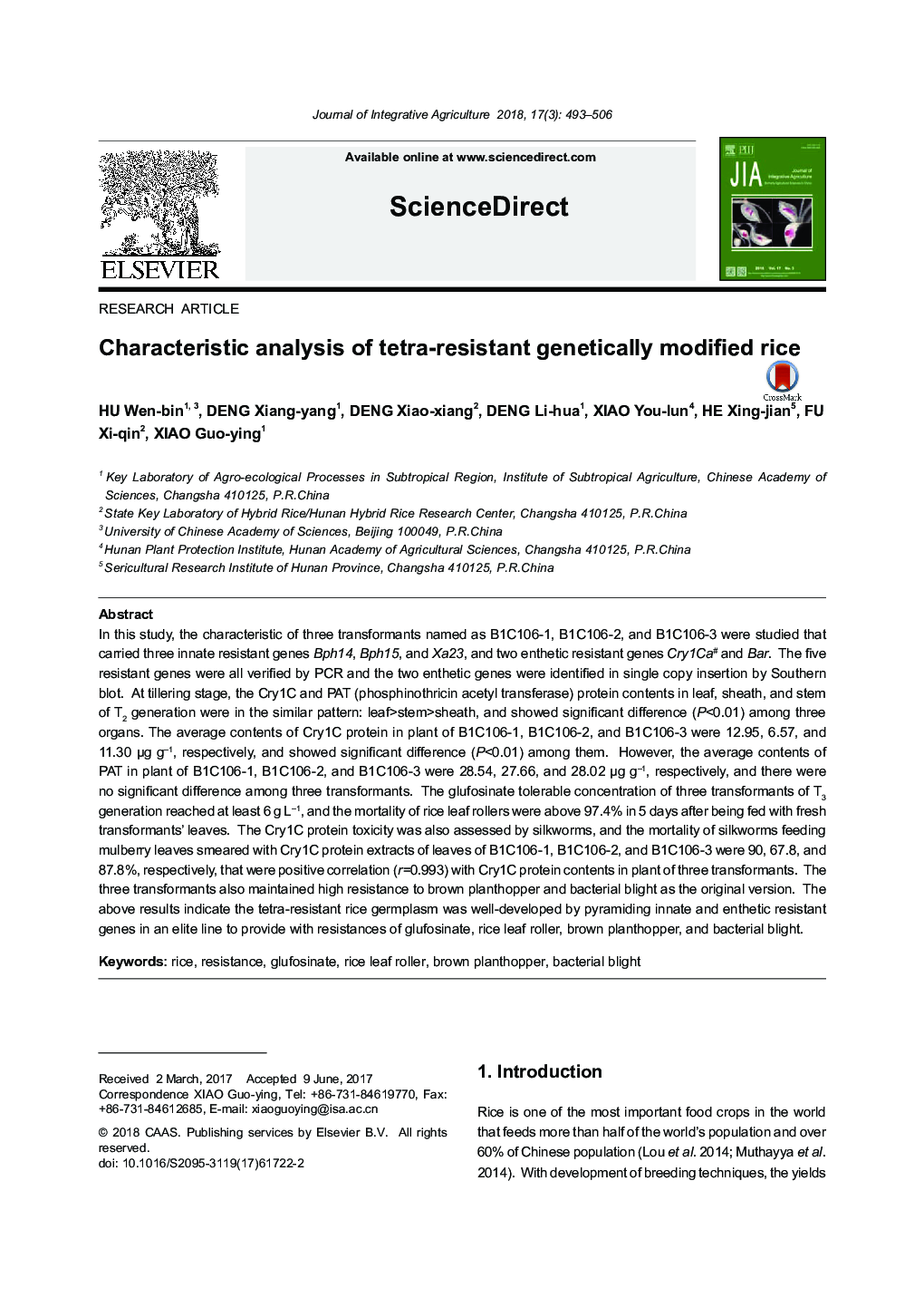| کد مقاله | کد نشریه | سال انتشار | مقاله انگلیسی | نسخه تمام متن |
|---|---|---|---|---|
| 8875661 | 1623699 | 2018 | 14 صفحه PDF | دانلود رایگان |
عنوان انگلیسی مقاله ISI
Characteristic analysis of tetra-resistant genetically modified rice
ترجمه فارسی عنوان
تجزیه و تحلیل مشخصه برنج اصلاح شده ژنتیکی مقاوم به
دانلود مقاله + سفارش ترجمه
دانلود مقاله ISI انگلیسی
رایگان برای ایرانیان
کلمات کلیدی
موضوعات مرتبط
علوم زیستی و بیوفناوری
علوم کشاورزی و بیولوژیک
علوم کشاورزی و بیولوژیک (عمومی)
چکیده انگلیسی
In this study, the characteristic of three transformants named as B1C106-1, B1C106-2, and B1C106-3 were studied that carried three innate resistant genes Bph14, Bph15, and Xa23, and two enthetic resistant genes Cry1Ca# and Bar. The five resistant genes were all verified by PCR and the two enthetic genes were identified in single copy insertion by Southern blot. At tillering stage, the Cry1C and PAT (phosphinothricin acetyl transferase) protein contents in leaf, sheath, and stem of T2 generation were in the similar pattern: leaf>stem>sheath, and showed significant difference (P<0.01) among three organs. The average contents of Cry1C protein in plant of B1C106-1, B1C106-2, and B1C106-3 were 12.95, 6.57, and 11.30 μg gâ1, respectively, and showed significant difference (P<0.01) among them. However, the average contents of PAT in plant of B1C106-1, B1C106-2, and B1C106-3 were 28.54, 27.66, and 28.02 μgâ1, respectively, and there were no significant difference among three transformants. The glufosinate tolerable concentration of three transformants of T3 generation reached at least 6 g Lâ1, and the mortality of rice leaf rollers were above 97.4% in 5 days after being fed with fresh transformants' leaves. The Cry1C protein toxicity was also assessed by silkworms, and the mortality of silkworms feeding mulberry leaves smeared with Cry1C protein extracts of leaves of B1C106-1, B1C106-2, and B1C106-3 were 90, 67.8, and 87.8%, respectively, that were positive correlation (r=0.993) with Cry1C protein contents in plant of three transformants. The three transformants also maintained high resistance to brown planthopper and bacterial blight as the original version. The above results indicate the tetra-resistant rice germplasm was well-developed by pyramiding innate and enthetic resistant genes in an elite line to provide with resistances of glufosinate, rice leaf roller, brown planthopper, and bacterial blight.
ناشر
Database: Elsevier - ScienceDirect (ساینس دایرکت)
Journal: Journal of Integrative Agriculture - Volume 17, Issue 3, March 2018, Pages 493-506
Journal: Journal of Integrative Agriculture - Volume 17, Issue 3, March 2018, Pages 493-506
نویسندگان
Wen-bin HU, Xiang-yang DENG, Xiao-xiang DENG, Li-hua DENG, You-lun XIAO, Xing-jian HE, Xi-qin FU, Guo-ying XIAO,
